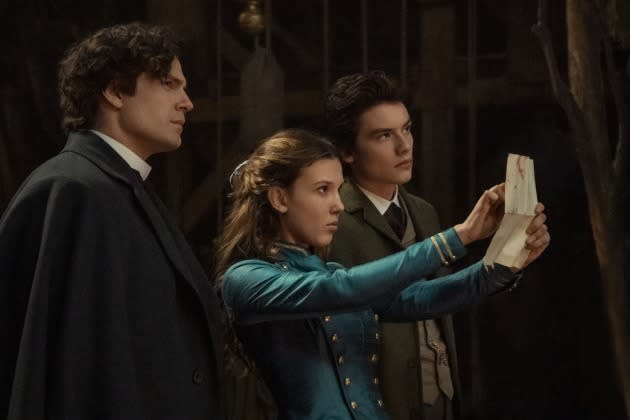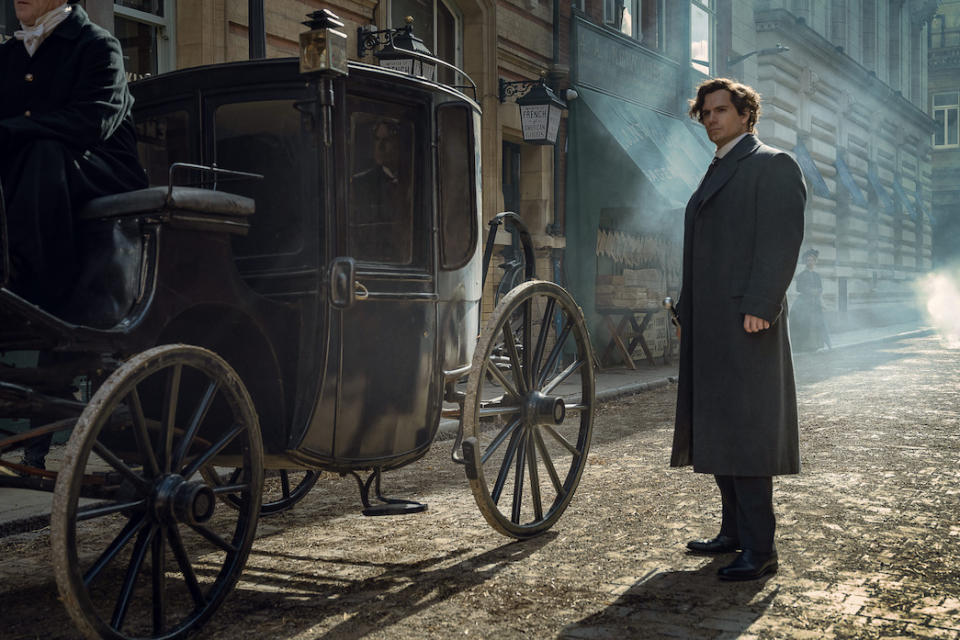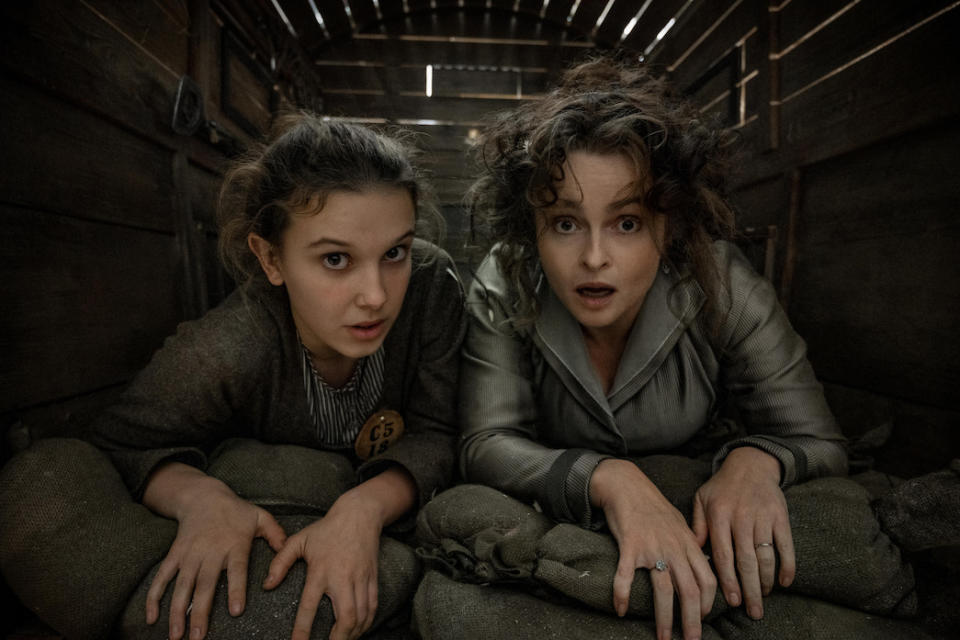Millie Bobby Brown & Harry Bradbeer On Pulling Henry Cavill Out Of His “Comfort Zone” With ‘Enola Holmes 2’
- Oops!Something went wrong.Please try again later.
- Oops!Something went wrong.Please try again later.
- Oops!Something went wrong.Please try again later.
- Oops!Something went wrong.Please try again later.
- Oops!Something went wrong.Please try again later.

In Enola Holmes 2, a new game is afoot! And this time, it’s ripped straight from the history books. Following the theme of female empowerment from the first film in 2020, director Harry Bradbeer (Fleabag), writer Jack Thorne (His Dark Materials) and actress Millie Bobby Brown (Stranger Things) felt it was important to highlight real stories about female oppression and liberation against the backdrop of the real-life matchgirls’ strike of 1888.
“We developed the script together,” Bradbeer tells Deadline. “We wanted to find a way that brought Enola into contact with a whole new world and range of young women and girls. And when we hit on the historical period, the idea of the matchgirls’ strike seemed to be a perfect way of telling a story about sisterhood and union and having the courage to stand up.”
More from Deadline

In the sequel, Enola (Brown) finds herself caught between the societal pressures of being a young girl on the cusp of womanhood and running her own detective agency. Because she is widely known as Sherlock Holmes (Henry Cavill)’s little sister, Enola often finds herself undermined and challenging the perceptions of her talents to her potential clients. Having branched out into the fields of cosmetics and becoming an executive producer in addition to being an actress, the delicate balance of navigating preconceived notions is something that Brown could also relate to.
“I think the industry can easily have its faults and its great accomplishments,” Brown says. “This is one of them. Yes, of course I’ve been undermined in the past, but we don’t focus on those things. We focus on the positives, and I have not been undermined in this situation. I was given an opportunity to be a female lead in a film. And that is a step forward.”
Below, Bradbeer and Brown discuss crafting female-led stories, growing alongside your film, pulling Henry Cavill out of his comfort zone and much more.
DEADLINE: What was something that you wanted to emphasize and expand upon this time around in the sequel?
HARRY BRADBEER: Because Millie was going to be two years older since we filmed the first movie, it was perfect to see and have this character grow up with her. I don’t know how many we’re going to make, but if you think of Enola Holmes, it’s a story of a young girl’s transition into womanhood and how she changes and deals with the challenges that she faces. So, we knew that having decided to be a detective, she was going to set out on a real case–and it was going to be difficult and messy. And now that she was in London, we were keen to make it reflect that time. Because London in the 1880s was dark and dangerous, as you discover when you see the film.
DEADLINE: The first movie dealt with themes about human rights and female autonomy, but this one is based on a true historical event about the matchgirls’ strike of 1888, which is a deviation from the book series. What led you highlight this story surrounding Sarah Chapman for the movie?
BRADBEER: We developed the script together, and as we talked about the story, we wanted to find a way that brought Enola into contact with a whole new world and a whole new range of young women and girls. And when we hit on the historical period, the idea of the matchgirls’ strike seemed to be a perfect way of telling a story about sisterhood and union and having the courage to stand up. And Millie really responded to that as well.
MILLIE BOBBY BROWN: The first time around I was by myself. I was this girl trying to find herself. And the second time when Harry pitched me the idea, I thought, “Oh my gosh, I’m going to be working with more women–that’s perfect.” This is exactly what I wanted the film to be about. I don’t mind not being the only one. I really want others to be a part of the film. And I think for me to be able to have Sharon [Duncan-Brewster], Serrana [Su-Ling Bliss], and Susie [Wokoma] and Helena [Bonham Carter] back, I was sold the first second he told me. I was very excited.
DEADLINE: This movie has rather large fight scene with Helena Bonham Carter beating up David Thewlis with the rest of the crew, how did this come about?
BRADBEER: We were lucky that we had a real event in time to pull from. And as we say at the beginning of the film, the important parts are true, that you see in the movie. It took a day to shoot as we had to work on it very quickly.
BROWN: Which is why I think it came out so good. Because we were just under a time crunch. We were all fighting for the light.
BRADBEER: Yeah, and Helena went to the loo every half an hour. [laughs]
BROWN: It’s true. Helena always needs a wee. [laughs]
BRADBEER: We went back and forth on the fighting [choreography], but it was so fun. Susan actually punched the guy she has a fight with in the movie and sent him down–he’s the man who’s on his knees with blood pouring out of his nose–and our stunt coordinator says, “Don’t worry about him. That’s his job. He’s fine. What’s the next shot?” And she felt so terrible about it. Her knuckles were actually bruised too. [laughs]
BROWN: Susie is so badass. She’s really good at fighting, she’s the best out of all of us put together. And obviously, Helena is just a force of nature so to watch her fight in general is so entertaining. And then for me, it was fun because I was watching those two fight like, “Are we really going to do this?” And then I had to connect the dots and go, “Oh, we’re going to fight.” And being able to go on that adventure and that journey in that moment, it was so fun to shoot. And then poor Thewlis…
BRADBEER: Thewlis had a hard time.
BROWN: He did.
BRADBEER: He got bashed a lot. There was a moment when we had changed the sequence so many times that night before shooting, when poor Millie was completely exhausted, I think I think she was standing there in a dressing gown and fluffy slippers, and we said, “OK, we’re just doing a little bit of a different approach to some of the fight.” And her face just fell. And then she had to work it out on the floor on the day. And there’s a moment, when you kicked him in the face and threw some move, and you go, “Yes.”
BROWN: I did, I kicked him. 100 percent. I finally got it right, and you kept it in, which I think is so funny because it’s such an Enola thing, and it’s also very much a Millie thing.
BRADBEER: Also, I just want everyone to know that David is fine now. [laughs]

DEADLINE: Occasionally Enola has to lean on her brother Sherlock at times to help her solve a problem. On set, who is the better problem solver? Who’s the least likely to break their lines or get the vibe of a scene right on the first table read?
BRADBEER: I think they all nailed it on the table read. Henry [Cavill] was incredible at the table read.
BROWN: I would say Henry. Henry is a problem solver. He’s a very rational man. Me, I’m a bit manic. I’ll try everything in order to solve something. Whereas he usually just gets it dead on right.
BRADBEER: He does, but also, he’s learning to be fun. In a way, Henry, like Sherlock, has a very rational approach but is learning more and more to have fun and to be spontaneous. And of course, Millie and he had this very interesting, enjoyable dynamic where they’re always poking at each other. And Millie tickles him up a little bit and surprises him. And he goes with it.
BROWN: He does. It’s shocking because he doesn’t have any sisters. So, for him, it must be completely different. I have a sister, a brother, and an older brother. So, I’m very much used to that kind of dynamic. I had to implement a lot of that into my relationship with Henry offscreen and onscreen and just pull him out of his comfort zone.
BRADBEER: Henry and I both don’t have little sisters and would’ve liked to have little sisters, which probably explains our enjoyment to working with people like Millie.
DEADLINE: In building this relationship and dynamic with Henry Cavill vs. your Stranger Things family Noah Schnapp and Charlie Heaton, is there a difference in creating this camaraderie that you noticed while shooting?
BROWN: It’s different because I grew up with Noah and Charlie. I met them when I was 10. So, for me, it does feel like your schoolmates. And with Henry, it feels like a real adult relationship. Like a really good friendship, a really healthy one. One that we have terms and conditions. I know Henry. He has terms and conditions with me. I’m not allowed to ask about his personal life. It’s like, “Millie, shut up. No.” And I’m like “Understood.” Whereas with the Stranger Things kids, it’s different. There’s no boundaries because it’s like we’re all siblings. But with Henry, he’s very strict with me, which I appreciate.
DEADLINE: In the film Enola starts her own detective agency and finds out quickly that she’s often undermined and has to prove her worth to people who are looking for her services. In your own career, you started out with a lot of monster and sci-fi roles. As you continue to establish yourself as an actress, are you still finding yourself undermined as you’re moving up in your career?
BROWN: No, I think we are progressing slowly as a united front. But I think the industry can easily have its faults and its great accomplishments. This is one of them. Yes, of course I’ve been undermined in the past, but we don’t focus on those things. We focus on the positives, and I have not been undermined in this situation. I was given an opportunity to be a female lead in a film. And that is a step forward.
DEADLINE: What did you both learn about yourselves in the process of making the two films?
BRADBEER: I discovered that I really love making this kind of family adventure film, which I had not expected to do. I’d worked in straight drama. There has always been a level of comedy. But the world building of Enola Holmes was more fun and more me than I realized. Also just realizing all the things it takes to put one of these kinds of movies together, and how important these huge sets and designs are even with VFX. You’ve got a crew of thousands of people and it still comes down to performance, nuance, comedy, life and believing what you see in front of you. That’s the thing. Don’t let other stuff confuse you. Focus in on the character and the story.
BROWN: And to add to that, Harry, came into the first film with the expertise of it. He’s such an attention to detail kind of director, which is what makes the film so immersive. Everyone on set knows Harry and his way and his spirit. The dedication to the film is unlike all of us put together. So yes, it does come down to performance, but it also very much comes down to directing and being able to have a connection with your director. It’s a dream come true.As for me, I learned many things, because I’m an upcoming young woman and that is a real learning curve for me. This is a very big pivotal moment within my career and my life. This is the first role I’ve really led.
BRADBEER: Another thing I learned working with Millie is that I couldn’t believe that someone, who was just 15 when we started, was so smart and aware of what the character could be, but at the same time completely alive in the moment. And that’s not something that people have a great deal. You have technical actors, and you have people who are spontaneous and alive who can improvise. Very few can spin those two plates. And she could do it.
BROWN: It’s funny because Harry and I had a meeting at the very beginning of the first Enola. And I think he was trying to gauge how we both work, and I was definitely trying to gauge how he works. [laughs]. And we were both talking, and I said, “Listen, Harry, I am just very instinctual. You just roll, and I’ll do anything. I really will.” And then he learnt that. And then on the first one, it was all I did. And then on the second one it was like that trust we had built together was then turned into this spontaneous journey together. And then we were just making other actors in the film do it too because it was really fun. Especially seeing Henry be spontaneous. [laughs]
BRADBEER: Oh, he was great. And that’s the other thing, when we knew in the table read, I said to Henry before, “You’re going to have to speak faster than you’ve ever spoken in your life. You’re going to go like a rocket. And right from that table read, he just said, “I love this. This is amazing.” And he just did it. And we all sat up.
Enola Holmes 2 launches Friday on Netflix.
Best of Deadline
Sign up for Deadline's Newsletter. For the latest news, follow us on Facebook, Twitter, and Instagram.

